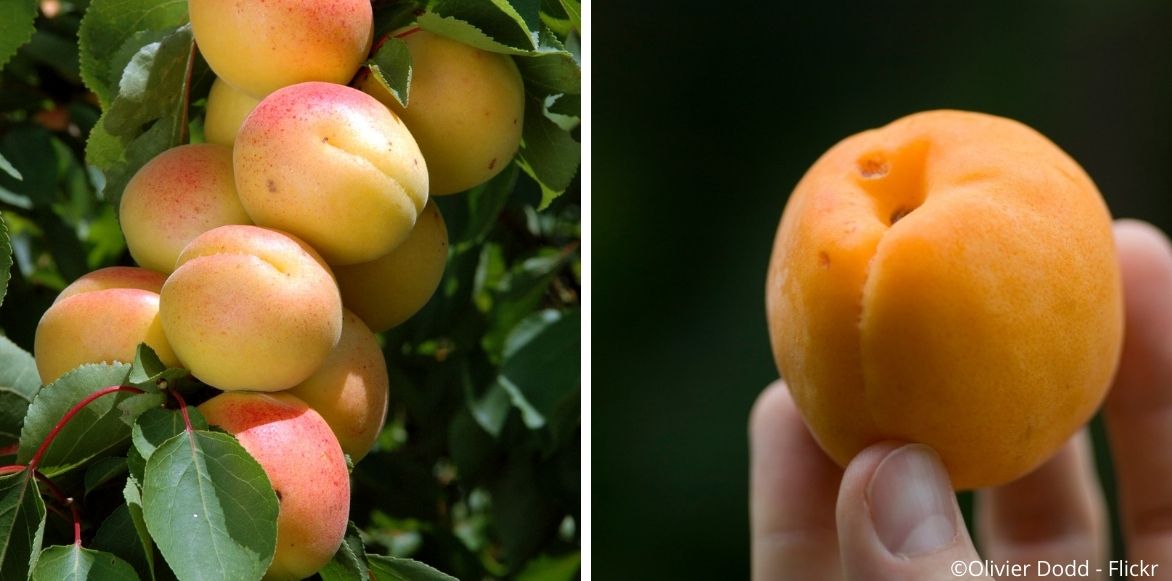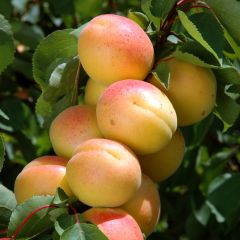
Aprium : planting, pruning, harvest
Contents
Aprium in a nutshell
- It is a hybrid fruit close to the apricot
- It has the flavour of apricot with a hint of plum
- The harvest takes place from June to August
- It is consumed like apricots, fresh or prepared
- Very hardy, it grows easily in the sun to ripen its fruits well in well-drained, light soil
A word from our expert
The aprium, or Prunus x Aprium is a hybrid fruit bush resulting from the cross-breeding between the apricot tree and the pluot or plumcot. It produces orange fruits with a velvety skin in summer, similar to apricots, such as the Aprium® Cot’n Candy®. Their flesh, equally sweet and fragrant, is enhanced by a hint of plum. They can be eaten fresh or used in desserts, jams, and more.
This fruit tree is easy to grow in the garden or orchard, requiring only a sunny spot, sheltered from cold winds in colder regions, and well-drained soil. You just need to prune it each year to enjoy bountiful harvests.
Discover our tips for planting, pruning, and harvesting it properly!
Description and Botany
Botanical data
- Latin name Aprium
- Family Rosaceae
- Common name Aprium
- Flowering March-April
- Height 4-5 m
- Sun exposure Sun
- Soil type Rich, cool, well-drained
- Hardiness -15 °C and beyond
The aprium, or Prunus x Aprium is a fruit bush belonging to the genus Prunus and the family Rosaceae, like the apricot tree, almond tree, and peach tree. It is a species resulting from hybridization between the apricot tree and the Pluot or plumcot (a cross between a plum and an apricot). It contains 75% of the genome of the plum tree (Prunus domestica) and 25% of the apricot tree (Prunus armeniaca). Just like the Pluot, its hybridization was developed in the late 1980s in California by Chris Floyd Zaiger, a breeder and developer of stone fruit hybrids. The aprium, like its parent the pluot, is a registered trademark of Zaiger’s Genetics. Several generations of cross-breeding were necessary to create this new fruit. Today, many varieties of aprium with varying earliness have been developed.
The aprium forms a spreading tree reaching 4 to 5 m in height at maturity, which is smaller than an apricot tree. It spreads naturally over time. The branches display deciduous foliage. The alternate, rounded leaves, green in colour and measuring 6 to 15 cm long, appear in spring. Attached by a long petiole, they are glossy, irregularly dentate on the margins, and veined.
The flowering of the aprium occurs in March-April, at the very beginning of spring, usually before the leaves. It is one of the first flowerings of the year, along with those of apricot and almond trees. Numerous small flowers typical of the Rosaceae family, pinkish-white in colour, appear singly at the tips of the current year’s shoots. They bloom in cup shapes composed of 5 pedunculate petals surrounded by sepals. Melliferous and nectariferous, they are pollinated by foragers.
Most varieties of aprium are self-fertile and do not require the presence of an apricot tree nearby for good fruiting. It takes about 3 to 4 years before the first harvest. The flowers are followed by the formation of fruits. Large, round fruits about 6 cm in diameter, with velvety skin, appear from June. Their epidermis is a beautiful powdery orange with red, slightly velvety. Their colour, the small typical crease that runs across their epidermis, and their shape resemble that of the apricot. They contain sweet, very fragrant white flesh, with a tart flavour similar to that of the apricot, with notes of raspberry, plum, and orange. These fleshy fruits weigh about 75 to 85g and are slightly less juicy than apricots.

Fruit of the Aprium
Read also
Pluot : planting, cultivation, harvestMain varieties

Aprium Cot'n Candy
- Flowering time May
- Height at maturity 4,50 m
Discover other Aprium trees
View all →
Available in 2 sizes
Planting aprium
Where to plant it?
Very hardy, able to withstand temperatures down to -20°C, the aprium can acclimatise anywhere in France as long as it is given a sunny spot well sheltered from the winds from the North and East, which may damage the flowering. Like those of the apricot tree, its flowers are sensitive to spring frosts.
In the northern regions of France, place it against a south-facing wall that will help protect the tree from the cold.
Like many fruit trees, it should be planted in full sun in any light, deep, and well-drained soil, even stony and slightly calcareous. Accommodating, it adapts to many types of soil, except those waterlogged which promote the onset of diseases.
It naturally finds its place in an orchard but also in an ornamental garden, either isolated on a short grass meadow or at the back of a flower bed, as its spring flowering is a delight. It can be trained in open forms (standard, half-standard, goblet). While most varieties are self-fertile, they will fruit better with the presence of an apricot tree planted nearby.
When to plant it?
The aprium is preferably planted from October to November when there is no frost, or alternatively in spring with regular watering to ensure recovery.
How to plant it?
If you wish to plant several specimens, space them at least 5 to 6 m apart. If your soil is too compact and heavy, it is essential to improve drainage (gravel, sand, or compost).
- For bare-root plants, soak the roots for a day in pralin
- Loosen the soil deeply
- Remove stones and unwanted weeds
- Dig a hole two to three times wider and deeper than the root ball
- Spread a layer of drainage at the bottom (especially if your soil is heavy)
- Add some well-decomposed compost at the bottom of the hole
- Place the root ball and cover with garden soil, gently firming it down as you go to remove air pockets between the roots and the soil
- Create a basin around the base and water generously and regularly to encourage rooting
Care and Pruning of Aprium
After planting in the first two years, ensure regular watering, allowing the soil to dry out between waterings. After that, it will require a bit of attention, and you should only water during periods of intense heat.
At the beginning of spring, apply well-matured compost by scratching it into the surface or fertiliser for fruit trees.
In winter, you can also add a handful of wood ash, rich in potash, to improve fruiting.
When and how to prune the aprium?
Pruning the aprium helps maintain good fruiting. Prune with a well-sharpened and thoroughly cleaned pruning shear and coat the wounds with healing paste to prevent diseases.
Training Pruning
During the first 3 years, prune with a pruning shear to remove dead branches and those that cross over each other, keeping only 5 beautiful main branches.
→ to read on the subject: “How to train a fruit tree in a goblet shape?”
Maintenance Pruning
Each year, in autumn or at the end of winter, remove the suckers by cutting them close to the main branch and slightly trim the tips of the shoots. Eliminate dead wood and damaged or broken branches, as well as those that cross over each other to thin out the branches.
Fruiting Pruning
In early June, when the fruits begin to form: remove some, keeping only the largest. Thinning allows for larger fruits, and you can repeat the operation 2 or 3 times.
Diseases and potential pests
Aprium can be subject to various diseases. Against cryptogamic diseases (powdery mildew, moniliosis) that cause a white fluff on the leaves or the wilting of flowers and the rotting of fruits on the tree, treat the tree preventively in spring with sprays of Bordeaux mixture.
Against rust that causes yellow and brown spots on the top and underside of the leaves, spray a horsetail decoction or Bordeaux mixture.
Multiplication
Aprium is propagated by grafting. An apricot tree is usually used as the rootstock. This is a technique that requires a certain level of skill, and we recommend reserving it for professional gardeners.
When and how to harvest apriums?
The aprium fruits 3 to 4 years after planting. The harvest spreads from late June to August, depending on the regions and varieties. Simply pick the fruits by hand when they are ripe, well orange and tender to the touch. You can pick them just a little before they reach ripeness; they will continue to ripen after harvest.
Conservation and Uses
Apriums can be stored for up to five days at room temperature. Once washed, dried, and pitted, they can be frozen.
They are consumed like apricots: fresh, dried, or prepared in desserts, fruit salads, jams, juices, ice creams, or as a side dish with savoury dishes.
They are rich in fibres, antioxidants, beta-carotene, vitamins A and C, and trace elements.
Useful resources
-
- All the tips for successfully growing, protecting, and maintaining your fruit trees
- Subscribe!
- Contents































Comments